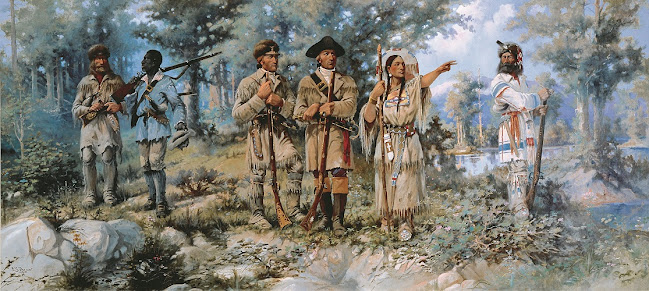Review by Bill Doughty––
Sometimes an old book can inspire a new understanding.
Stephen E. Ambrose’s “Undaunted Courage: Meriwether Lewis, Thomas Jefferson, and the Opening of the American West” (Simon & Schuster, 1996) has been sitting on my library shelf for more than 20 years. Ambrose is no McCullough, but he was passionate to the point of near obsession about this subject. I finally slogged through “Undaunted” over the summer because I wanted to learn more about the Lewis & Clark trail.
 |
The mission itself was an unsuccessful attempt to find a water route across the continent. The Lewis & Clark team was an infantry company of the U.S. Army called the “Corps of Discovery.” Jefferson commissioned the expedition as the Louisiana Purchase came to light and efforts were made to fend off French and British claims. An objective was “to establish American sovereignty, peace, and a trading empire.”
This book comes with wonderful charts by A. Karl and J. Kemp showing the various routes the team took along the Missouri River, through what are now Iowa, Nebraska, the Dakotas, Montana, Idaho, Washington, and Oregon, all the way to the Pacific Ocean.
At the time, Virginia pointed toward the West, and St. Louis was the very edge of the American frontier in the early 1800s.
Trained in exploration, armed with mapping tools, and taught how to preserve specimens, Lewis discovered species of animals and plants previously unknown to Europeans. He received help from Clark and two dozen enlisted soldiers, from many civilians who lived among or traded with the Indians, and from hundreds of Indians themselves.
Jefferson was inspired to commission the expedition after reading a book by Alexander Mackenzie, a Scotsman who explored parts of the Pacific Northwest and called for a British claim to a Northwest Empire in 1793. Both Jefferson and Lewis were inspired by Capt. James Cook’s 1784 book, “A Voyage to the Pacific Ocean.”Ambrose paints a time of antiquity –– where slavery, patriarchy, and hardship were normal and accepted. Where time itself was measured in how long it took to travel by horse. No telephones. No engines. No antibiotics. No mosquito repellant. No sunglasses or sunscreen. No GPS.
How most of the members of the expedition managed to survive the arduous journey is a story of luck, grit, and resilience. And it’s a story of the abundance of the North American continent in the early 1800s. The expedition killed thousands of deer, buffalo, elk, beaver, and other wildlife. They gorged on salmon and, when necessary, ate horses and dogs.
Lacking humility but with an abundance of confidence, Lewis met with various tribes and tried to “coerce through commerce,” trading beads, tobacco, and tools for horses, information, and services. He promised the Indians their “father” in Washington would take care of them. He gave them American flags, certificates, and medals. He cajoled and threatened.
“Lewis did all this with the utmost seriousness,” Ambrose writes. “It never occurred to him that his actions might be characterized as patronizing, dictatorial, ridiculous, and highly dangerous.”
But, “Virtually all Indian parties proved resistant to change and suspicious of American motives.” Nevertheless, many tribes helped the expedition find food, trails, and water routes. Lewis and Clark astutely tried to identify the chiefs and deal directly with them. As with U.S. military leaders, the chiefs were often chosen from those who had proved themselves in combat.
Ambrose praises Lewis’s ability as a “near-perfect army officer” and a “great company commander, the greatest of all American explorers, and in the top rank of world explorers.” The U.S. Navy has named several ships related to the expedition. Most notably, the current class of dry cargo replenishment ships is known as Lewis and Clark and includes the namesakes USNS Lewis and Clark (T-AKE 1) and USNS Sacagawea (T-AKE 2).
 |
Airman Brandy Phillips, aviation boatswain's mate (fuels), stands watch in primary flight control aboard the multi-purpose amphibious assault ship USS Bataan during a vertical replenishment with the Military Sealift Command dry cargo and ammunition ship USNS Sacagawea in support of Operation Unified Response off the coast of Haiti after a 7.0 magnitude earthquake, Jan. 12, 2010. (CPO Tony Sisti)
Lewis’s journals were eventually published. His book inspired the great movement West and creation of the American Empire that Jefferson envisioned.
After his return, Lewis went to Philadelphia and went to parties and dinners with his best friend, Mahlon Dickerson, a lawyer who later served as governor of New Jersey, Senator from New Jersey, and Secretary of the Navy under President Andrew Jackson. Lewis, who showed signs of depression, became a heavy drinker and took opium at night.
 |
| Lewis, Clark, and Jefferson |
Ambrose does not shy away from showing the shortcomings of Meriwether Lewis, William Clark, and Thomas Jefferson. All were privileged and dedicated slave owners who also took advantage of native Americans. They wanted to “civilize” and move the Indians out of the way so white settlers could move in a set up a fur trade and land trade. Lewis’s policies were, in Ambrose’s words, “nothing short of genocide.”
Sometimes an old book can inspire a new understanding. Today is Native American Heritage Day.




No comments:
Post a Comment